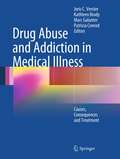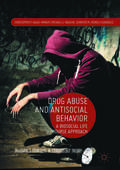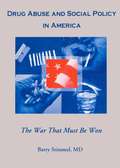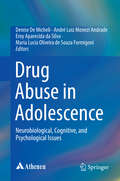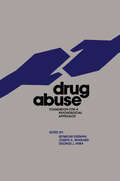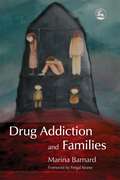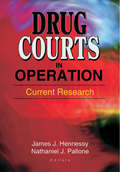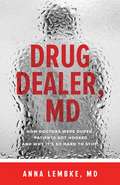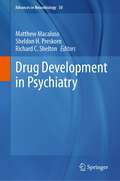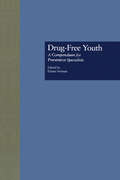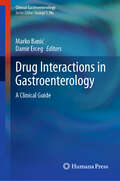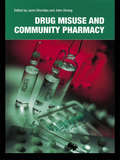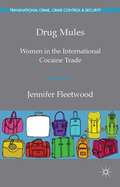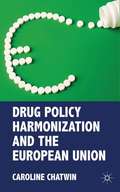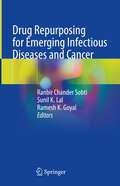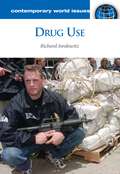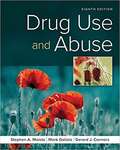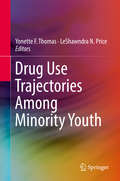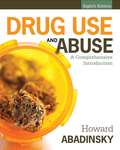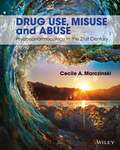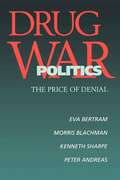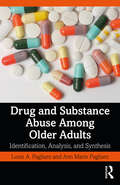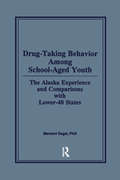- Table View
- List View
Drug Abuse and Addiction in Medical Illness
by Marc Galanter Kathleen Brady Patricia Conrod Joris C. VersterDrug abuse and addiction are common in clinical practice. Often they interfere with patient treatment or require an alternative approach. Drug Abuse and Addiction in Medical Illness: Causes, Consequences, and Treatment is a major contribution to the literature, a gold standard title offering a comprehensive range of topics for those who care for patients with addiction, conduct research in this area, or simply have an interest in the field. Offering state-of-the-art information for all those working with drug abusing or addicted patients, or for those interested in this topic from other research perspectives, the volume is a first of its kind book -- rich, comprehensive, yet focused, addressing the needs of the very active theoretical, basic, and clinical research in the field. Comprised of 46 chapters organized in four sections and developed by the leading international experts, Drug Abuse and Addiction in Medical Illness: Causes, Consequences, and Treatment covers virtually every core, as well as contemporary, topic on addiction, from the established theories to the most modern research and development in the field. Enhancing the educational value of the volume, every chapter includes an abstract and two boxes summarizing learning objectives and directions for future research. Drug Abuse and Addiction in Medical Illness: Causes, Consequences, and Treatment discusses the topic in a authoritative, systematic manner and is an indispensable reference for all clinicians and researchers interested in this rapidly changing field.
Drug Abuse and Antisocial Behavior
by Michael G. Vaughn Christopher P. Salas-Wright Jennifer M. Reingle GonzálezThis book is rooted in the conviction that human biology plays a critical role in understanding drug abuse and antisocial behavior. In the same breath, however, it fundamentally affirms the importance of the many social and environmental factors that influence our behavior across the life course. The study begins with an overview of the scope of the problem of drug abuse and crime, and an examination of how these problems often feed into one another. Building upon that foundation, the focus shifts to a review of cutting-edge research on the genetics and neurobiology of addiction and antisocial behavior across the developmental periods of childhood, adolescence, and adulthood. An exploration of the implications of a biosocial life course approach in terms of drug abuse prevention, and an examination of what lies ahead for drug abuse and criminological research conclude this detailed and timely book. Policy makers, practitioners and scholars of criminology and sociology will find this of particular interest.
Drug Abuse and Social Policy in America: The War That Must Be Won
by Barry StimmelIllicit drugs, despite the “war” waged by the United States government, remain a tremendous drain on the American economy and continue to take their toll on the lives of countless Americans. A comprehensive text with an instructor's manual, Drug Abuse and Social Policy in America analyzes why current US policy on the use of licit and illicit mood-altering drugs has failed. This groundbreaking book addresses differences between decriminalization, legalization, and “zero tolerance”--areas and philosophies that are poorly understood--and suggests a multipronged approach to diminish inappropriate drug use. Physicians, health care providers, teachers, law enforcement officers, policymakers, social service providers, and students of public policy and health will gain a better understanding of substance abuse as a societal problem, rather than an individual problem, and see that the billions of dollars spent on law enforcement would be better spent on education, prevention, treatment, and providing alternatives to drug use.Currently the leading risk factor associated with the transmission of HIV, illicit drugs continue to destroy the fabric of life in many inner-city communities. Yet, drugs are a problem for Americans from every corner of society, from suburban teenagers to pro athletes to homeless people. Author Barry Stimmel demonstrates in Drug Abuse and Social Policy in America that the drug problem is not being addressed adequately because of a lack of commitment from the majority of Americans and government leaders. The issues Drug Abuse and Social Policy in America asks readers to confront include:Why do we provide insufficient treatment facilities and incarcerate users, yet wonder why more prison space is needed?Why do we readily agree to build more prisons rather than community centers that provide alternatives for youths?Why are we concerned with teenage smoking and drinking, yet allow advertising of these substances?Why do we advocate rehabilitation, but not hire people in recovery?Why do we ask pregnant women with drug problems to seek help, then try to take custody of their children rather than provide social support while they receive treatment?Drug Abuse and Social Policy in America challenges academics, practitioners, and future social service providers and policymakers to rethink their entire conception of the problem of substance abuse in America with a cutting question: “Have we made any substantial progress in diminishing the sue of nicotine, the excessive consumption of alcohol, or the inappropriate use of prescription drugs, all of which are responsible for more illnesses and societal costs than all illicit drugs combined?” Identifying this as the place where all efforts to curb drug use must start, Drug Abuse and Social Policy in America offers readers many ways that individuals, communities, organizations, and society can take action and be more effective in convincing both those who consume drugs and those who profit from their sale that their actions are inappropriate and unacceptable.
Drug Abuse in Adolescence
by Denise Micheli André Luiz Monezi Andrade Eroy Aparecida da Silva Maria Lucia Oliveira de Souza-FormigoniFocusing on two central themes--the psychobiological evolution from youth to adult and the effects of drugs on the developing central nervous system--this important reference elucidates the mechanisms of chemical dependency in adolescents. Its multidisciplinary coverage analyzes addiction across major domains of human functioning against the backdrop of hormonal, cognitive, and other changes that accompany the transition to adulthood. Chapters discuss legal as well as illicit drugs, examine age-related social contexts, and present the latest findings on links between drug use and mental disorders. Throughout, the contributors make clear that education is more valuable to understanding--and preventing--substance abuse than are prohibition and zero-tolerance thinking. Included among the topics: Cognitive development, learning, and drug use. Neurobiology of the action of drugs of abuse. Findings in adolescents with substance dependence based on neuroimaging tests. Alcohol abuse in adolescents: relevance of animal models. Effects of chronic drug abuse on the chronobiology of sleep in adolescents. Neurological and cognitive disorders arising from the chronic use of drugs of abuse. The multiple lenses for understanding its subject and the sensitivity with which causal nuances are treated make Neuroscience of Drug Abuse in Adolescence an invaluable resource for clinical and child psychologists, psychiatrists, social workers, and addiction counselors.
Drug Abuse: Foundation for a Psychosocial Approach
by George J Huba Seymour Eiseman Joseph A WingardDeparting from largely ineffective medically-oriented approaches to the problems of drug abuse/education, the contributors to this volume present relevant empirical findings and theoretical models within a comprehensive psychosocial framework, which draws upon recent advances in understanding the physiological, psychological, interpersonal, and social forces that are the causes of youthful drug addiction.
Drug Addiction and Families
by Fergal Keane Marina BarnardDrug problems have a profound impact on families. Mothers and fathers, brothers, sisters and children are frequently caught in the maelstrom that drug problems almost inevitably create. Within the UK there is a serious lack of information on the experiences of families attempting to live and cope with a family members' drug problem. Drug Addiction and Families is an exploration of the impact of drug use on families, and of the extent to which current practice meets the needs of families as well as problem drug users. Drawing on a substantial research study comprising interviews with problem drug users and their extended family, Marina Barnard examines the effects of drug use not only on drug users themselves, but also the feelings of anger, sadness, anxiety, shame and loss that are commonly experienced by their extended family. She records the effects of drug use on family dynamics and relationships, including possible social and emotional costs. Its impact on the physical and mental health of family members is also discussed. The author highlights the often overlooked role of grandparents in protecting the children of drug users and considers the perspectives of practitioners such as teachers, social workers and health professionals. The conclusions drawn point to the fact that current service provision, in treating the problem drug user in isolation, fails to address the needs of drug-affected families, and misses the opportunity to develop family-oriented support and treatment. This accessible and insightful book is invaluable reading for drug workers, social workers, health professionals and all practitioners working with families affected by drug use.
Drug Courts in Operation: Current Research
by James Joseph HennessyExamine an innovative strategy for fighting the war on drugs!Drug Courts in Operation: Current Research provides an in-depth look at an increasingly utilized approach to rehabilitating substance abusers. Drug courts offer their participants a chance to better themselves by providing support and structure to those that do not have it in their life, offering substance abusers a chance to participate in rehabilitation in lieu of incarceration. This insightful book examines the history of drug courts as a principal treatment alternative to incarceration, outlines the risk factors of children living with drug-addicted parents, and introduces a program to help strengthen families.The book delivers vital information on: introducing programs to help prevent narcotic use by children with drug-addicted parents the need for cultural- and gender-specific treatment plans, especially in the treatment of women and African-American males treatment dosage effects the importance of length of participation to outcomes focus groups designed to help drug court participants with their employment needs predictors of engagement in court-mandated treatment programs how legal coercion of high-risk patients via the threat of incarceration motivates participants to succeed
Drug Dealer, MD: How Doctors Were Duped, Patients Got Hooked, and Why It's So Hard to Stop
by Anna LembkeThree out of four people addicted to heroin probably started on a prescription opioid, according to the director of the Centers for Disease Control and Prevention. In the United States alone, 16,000 people die each year as a result of prescription opioid overdose. But perhaps the most frightening aspect of the prescription drug epidemic is that it's built on well-meaning doctors treating patients with real problems. In Drug Dealer, MD, Dr. Anna Lembke uncovers the unseen forces driving opioid addiction nationwide. Combining case studies from her own practice with vital statistics drawn from public policy, cultural anthropology, and neuroscience, she explores the complex relationship between doctors and patients, the science of addiction, and the barriers to successfully addressing drug dependence and addiction. Even when addiction is recognized by doctors and their patients, she argues, many doctors don't know how to treat it, connections to treatment are lacking, and insurance companies won't pay for rehab. Full of extensive interviews-with health care providers, pharmacists, social workers, hospital administrators, insurance company executives, journalists, economists, advocates, and patients and their families- Drug Dealer, MD, is for anyone whose life has been touched in some way by addiction to prescription drugs. Dr. Lembke gives voice to the millions of Americans struggling with prescription drugs while singling out the real culprits behind the rise in opioid addiction: cultural narratives that promote pills as quick fixes, pharmaceutical corporations in cahoots with organized medicine, and a new medical bureaucracy focused on the bottom line that favors pills, procedures, and patient satisfaction over wellness. Dr. Lembke concludes that the prescription drug epidemic is a symptom of a faltering health care system, the solution for which lies in rethinking how health care is delivered.
Drug Development in Psychiatry (Advances in Neurobiology #30)
by Matthew Macaluso Sheldon H. Preskorn Richard C. SheltonThe book reviews clinical trial methodology as it pertains to drug development in psychiatry. The reader will understand the process of drug development in psychiatry from discovery through marketing with the help of clinically relevant examples. The reader will appreciate the history of drug development in psychiatry dating back to the era of serendipitous discovery and culminating in an era of new and highly focused targets. Readers will understand how drug development in psychiatry has changed and adapted with the discovery of novel mechanism of action drugs. Novel drugs and disease targets have changed the way developers and regulatory agencies think about clinical trial methodology.The book elucidates how biomarkers, genetics and advances in neuroscience and neuroimaging have influenced drug development approaches, which will ultimately change the practice of psychiatry. The book will be broken down into the following sections:a. Prior to the 1960s - Drug discovery by chance observationb. The last 50 years – refined targeting of CNS drugs without the discovery of mechanistically new drugsc. The future – the discovery and development of mechanistically new drugs. The examination of new targets, genetics and biomarkers.
Drug Dreams: Clinical and Research Implications of Dreams about Drugs in Drug-addicted Patients
by Claudio ColaceThis book completes a series of clinical and experimental observations on dreams about drugs of drug-addicted patients, providing a systematic and comprehensive discussion on drug dreams that involves various fields of study and, ideally, to suggest future clinical and research applications.
Drug Free Youth: A Compendium for Prevention Specialists
by Elaine NormanFirst published in 1997. Routledge is an imprint of Taylor & Francis, an informa company.
Drug Interactions in Gastroenterology: A Clinical Guide (Clinical Gastroenterology)
by Marko Banić Damir ErcegThe risk of clinically significant drug interaction rises when a patient increases his intake of medication. While drug interaction can be a prominent cause of illness, in many cases, it can be avoided with proper knowledge and care. This text provides a concise yet comprehensive review of common drug interactions in gastroenterology. The book begins with a preliminary overview of GI drugs, focusing on legal aspects of drug use, clinical research and regulatory review, and drug development. The next section goes over the basic pharmacology of GI drugs, specifically profiling antisecretory drugs, motility drugs, mucosal protective agents, antibiotics, and anti-inflammatory drugs. The third section of the text reviews important aspects of drug interaction; topics covered in this section include the different types of drug interactions, adverse drug reactions and interactions, enzymes and transporters involved in drug interactions, pharmacogenomics, drug-herbal interactions, drug-food interactions, and ways to avoid drug interactions altogether. The book moves on to examine comorbidity and digestive diseases that can result from drug interactions, with particular emphasis on infections, cardiorespiratory disorders, renal insufficiency, IBS, metabolic disorders, and CNS disorders. This section also discusses the influence of age on drug interactions. The final section spotlights comedication that can be used to mitigate disorders caused by drug interactions, specifically reviewing comedication used to treat acid-related disorders, intestinal inflammation, liver disorders, pancreato-biliary disorders, and motility disorders. The text also includes over 100 high-yield illustrations, photographs, and tables.
Drug Misuse and Community Pharmacy
by John Strang Janie SheridanDrug misuse is a major challenge for health professionals in the 21st century, and community pharmacy holds a key place in the management of prescribed medication, the provision of health education and promotion messages to drug users. Two decades ago there would have been no need for a book to describe such the role of community pharmacy; however,
Drug Mules
by Jennifer FleetwoodFleetwood explores how women become involved in trafficking, focusing on the lived experiences of women as drug mules. Offering theoretical insights from gender theory and transnational criminology, Fleetwood argues that women's participation in the drugs trade cannot be adequately understood through the lenses of either victimization or agency.
Drug Policy Harmonization and the European Union
by Caroline ChatwinThe issue of illegal drugs is one which impacts on all societies and one which does not respect national borders. It is, therefore, an ideal candidate for the development of an international policy response. The powerhouses of the European Union have expressed a desire to move towards an 'ever closer union' encompassing wider areas and deeper levels of policy, yet illegal drug policy has remained firmly in the control of the heads of member states. This book seeks to understand why it has been so difficult to harmonise in this area and explores both the desirability and the viability of a 'European drug policy'. Finally, it applies the popular European integration theory of multi-level governance to the issue of illicit drugs and suggests that, if harmonization of European drug policy were to develop along these lines, it would be both desirable and viable. "
Drug Repurposing for Emerging Infectious Diseases and Cancer
by Sunil K. Lal Ranbir Chander Sobti Ramesh K. GoyalThis book presents drug repurposing strategies to combat infectious diseases and cancer. It discusses key experimental and in silico approaches for modern drug repositioning, including signature matching, molecular docking, genome-wide associated studies, and network-based approaches aided by artificial intelligence. Further, the book presents various computational and experimental strategies for better understanding disease mechanisms and identify repurposed drug candidates for personalized pharmacotherapy. It also explores the databases for drug repositioning, summarizes the approaches taken for drug repositioning, and highlights and compares their characteristics and challenges. Towards the end, the book discusses challenges and limitations encountered in computational drug repositioning.
Drug Safety Evaluation
by Jean-Charles GautierNon-clinical drug safety evaluation, the assessment of the safety profile of therapeutic agents through the conduct of laboratory studies in in vitro systems and in animals, is an essential step in the progress of new pharmaceuticals heading toward the ultimate goal of clinical trials and, eventually, approval. In Drug Safety Evaluation: Methods and Protocols, expert researchers detail a compendium of analytical technologies with a focus on clarity and applicability in real life laboratory practice. These meticulous contributions feature key topics such as acute to chronic general toxicity studies, histopathology studies, reproductive toxicity studies, genotoxicity studies, safety pharmacology studies, investigative toxicity studies, and safety biomarker studies. As a volume in the highly successful Methods in Molecular Biology(tm) series, chapters include brief introductions to their respective subjects, lists of the necessary materials, step-by-step, readily reproducible protocols, and tips on troubleshooting and avoiding known pitfalls. Comprehensive and authoritative, Drug Safety Evaluation: Methods and Protocols serves as an ideal guide to this field, helpful to pharmaceutical scientists, toxicologists, biochemists, and molecular biologists as well as scientists from all other disciplines who wish to translate these thorough methods into their own work.
Drug Use
by Richard IsralowitzThe use of tobacco, alcohol, marijuana, heroin, cocaine, and other substances is a deeply imbedded characteristic of most societies. It often shows itself in the form of illness, death, crime and violence, police action and imprisonment, property confiscation, massive allocations of governmental resources, as well as many ways of human suffering. It tends to attract more concern and attention than any other social issue throughout the world.
Drug Use And Abuse (Mindtap Course List Ser.)
by Gerard J. Connors Stephen A. Maisto Mark GalizioDid you know that a drug's effects depend not only on its properties but also on the biological and psychological characteristics of its user? This theme is highlighted throughout DRUG USE AND ABUSE, 8th Edition. The book weaves historical, social, psychological, cultural, biological, and medical perspectives, taking an interdisciplinary approach in its coverage of current topics regarding drug use, problems associated with use, and their prevention and treatment. You'll learn about classes of drugs as well as the latest data on drug use patterns and social trends, such as the recent increase in heroin addiction, the altered social and legislative environment surrounding marijuana, and the use of technology in the treatment of the substance use disorders.
Drug Use Trajectories Among Minority Youth
by Yonette F. Thomas Leshawndra N. PriceThis volume examines trajectories of drug use among ethnic minority youth in the United States with a focus on African Americans and Hispanics. It also highlights what research designs have been employed to address these differences as well as suggests strategies for moving this discourse forward by identifying potential targets for prevention and intervention with minority youth. This book features essays by leading experts in the field who have grappled with this issue for decades. Inside, readers will find an insightful dialogue that addresses such questions as: Why are African American and Hispanic youth more likely than their White peers to abstain from drug use during adolescence but are more likely to become problem users later in life? What impact does the stress caused by discrimination have on potential drug use? To what extent does religiosity protect minority youth from drug use as past research suggests that it protects White youth? What is the influence of neighborhood context on exposure to and use of substances among urban African American children? Taken together, the essays in this book identify underexplored risk and protective factors and gaps in the current state of knowledge that can be used to develop effective, culturally specific drug abuse prevention strategies. This book is for anyone with an interest in the initiation and escalation of drug use among African Americans and Hispanics/Latinos and factors that influence these patterns over the life course. It will also be an ideal resource for those interested in better understanding the mechanisms by which risk and protective factors are related to the development of drug use and addiction, particularly the ways in which such factors contribute to health differences and have disproportionately more negative consequences for ethnic minorities.
Drug Use and Abuse: A Comprehensive Introduction (8th Edition)
by Howard AbadinskyPacked with the latest data and research, the powerful new DRUG USE AND ABUSE: A COMPREHENSIVE INTRODUCTION, 8e delivers a thorough, interdisciplinary survey of all aspects of drug and alcohol abuse. The text draws from the many disciplines of history, law, pharmacology, political science, social work, counseling, psychology, sociology, and criminal justice--resulting in the most comprehensive, authoritative single source available. It explores the history of drugs, their impact on society, the pharmacological impact of drugs on the body, drug policy implications, the criminal justice system response, the drug business, law enforcement, theories of use, as well as the effects, treatment, and prevention of abuse. New coverage includes nonmedical use of prescription drugs, synthetic substances, the use of stimulants to treat PTSD and ADD, medical marijuana, the connection between drug trafficking and terrorism, and an updated analysis of the United States drug policy.
Drug Use, Misuse, And Abuse
by Cecile MarczinskiBringing a new approach to covering the basic principles and major topics found in a typical psychopharmacology course, Drug Use, Misuse and Abuse also adds the newest exciting and controversial findings in the study of drug use and abuse. At the core, the text has a strong emphasis on developing scientific literacy and critical thinking in the student. <p><p> Drug Use, Misuse and Abuse includes the major drugs typically covered in an undergraduate psychopharmacology course (caffeine, nicotine, cocaine, amphetamines including methamphetamine, alcohol, opiates, marijuana, the hallucinogens, antipsychotics, antidepressants, and antianxiety medications) and, moreover, the content emphasizes the latest scientific findings in the field, including advances in imaging the living brain. Included is a chapter on careers related to psychopharmacology, as well as a variety of pedagogical features that help students learn, making it appropriate for an instructor of a lecture-based, online or hybrid course.
Drug War Politics: The Price Of Denial (Emersion: Emergent Village Resources For Communities Of Faith Ser.)
by Peter Andreas Kenneth Sharpe Eva Bertram Morris BlachmanWhy have our drug wars failed and how might we turn things around? Ask the authors of this hardhitting exposè of U.S. efforts to fight drug trafficking and abuse. In a bold analysis of a century's worth of policy failure, Drug War Politics turns on its head many familiar bromides about drug politics. It demonstrates how, instead of learning from our failures, we duplicate and reinforce them in the same flawed policies. The authors examine the "politics of denial" that has led to this catastrophic predicament and propose a basis for a realistic and desperately needed solution. Domestic and foreign drug wars have consistently fallen short because they are based on a flawed model of force and punishment, the authors show. The failure of these misguided solutions has led to harsher get-tough policies, debilitating cycles of more force and punishment, and a drug problem that continues to escalate. On the foreign policy front, billions of dollars have been wasted, corruption has mushroomed, and human rights undermined in Latin America and across the globe. Yet cheap drugs still flow abundantly across our borders. At home, more money than ever is spent on law enforcement, and an unprecedented number of people―disproportionately minorities―are incarcerated. But drug abuse and addiction persist. The authors outline the political struggles that help create and sustain the current punitive approach. They probe the workings of Washington politics, demonstrating how presidential and congressional "out-toughing" tactics create a logic of escalation while the criticisms and alternatives of reformers are sidelined or silenced. Critical of both the punitive model and the legalization approach, Drug War Politics calls for a bold new public health approach, one that frames the drug problem as a public health―not a criminal―concern. The authors argue that only by situating drug issues in the context of our fundamental institutions―the family, neighborhoods, and schools―can we hope to provide viable treatment, prevention, and law enforcement. In its comprehensive investigation of our long, futile battle with drugs and its original argument for fundamental change, this book is essential for every concerned citizen.
Drug and Substance Abuse Among Older Adults: Identification, Analysis, and Synthesis
by Louis A. Pagliaro Ann Marie PagliaroDrug and Substance Abuse Among Older Adults provides a timely, comprehensive overview and analysis of the silent epidemic of drug and substance abuse involving elderly Americans. Combining the authors’ individual 50-plus years of formal academic and clinical experience, the book presents a critical reflective analysis and synthesis of the published research associated with older adult psychotropic drug use and abuse in the United Sates. Chapters delineate related causes and consequences and provide the reader with guidance on how to minimize and effectively deal with this significant and growing problem. Related professional reminders throughout each chapter emphasize and remind readers of important basic content and principles, while common misbeliefs regarding specific abusable psychotropics and their use by older adults are debunked and corrected. Also included are carefully developed figures and tables to supplement chapter content along with explicit guides and tools to facilitate the assessment and diagnosis of abusable psychotropic dependence or use disorder. Health and social care professionals in the U.S. will learn to assess and diagnose abusable psychotropic dependence or use disorders among older adults and to provide clients quickly and accurately with appropriate, efficacious, and empirically validated treatment.
Drug-Taking Behavior Among School-Aged Youth: The Alaska Experience and Comparisons With Lower-48 States
by Bernard SegalUse this valuable knowledge about drug-taking behavior to plan strategies to prevent or reduce drug-taking among youth. The findings from this unique study have important implications for researchers, educators, practitioners, and local and state policymakers and planners for the development of initiatives for addressing smoking, drinking, and drug use among early adolescents and teenagers. The purpose of this informative volume is to further understand drug-taking behavior among adolescents by providing information on the prevalence, correlates, and consequences of drug-taking behavior among a large sample of adolescents. Although the focus is on Alaska, the findings generalize to comparably aged youth in general; moreover, comparisons with findings from national studies and other states provide interesting results.
